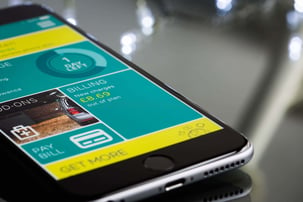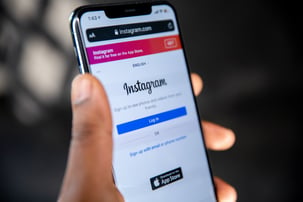How to Create a Successful Mobile Application in 2023? 15 Useful Tips
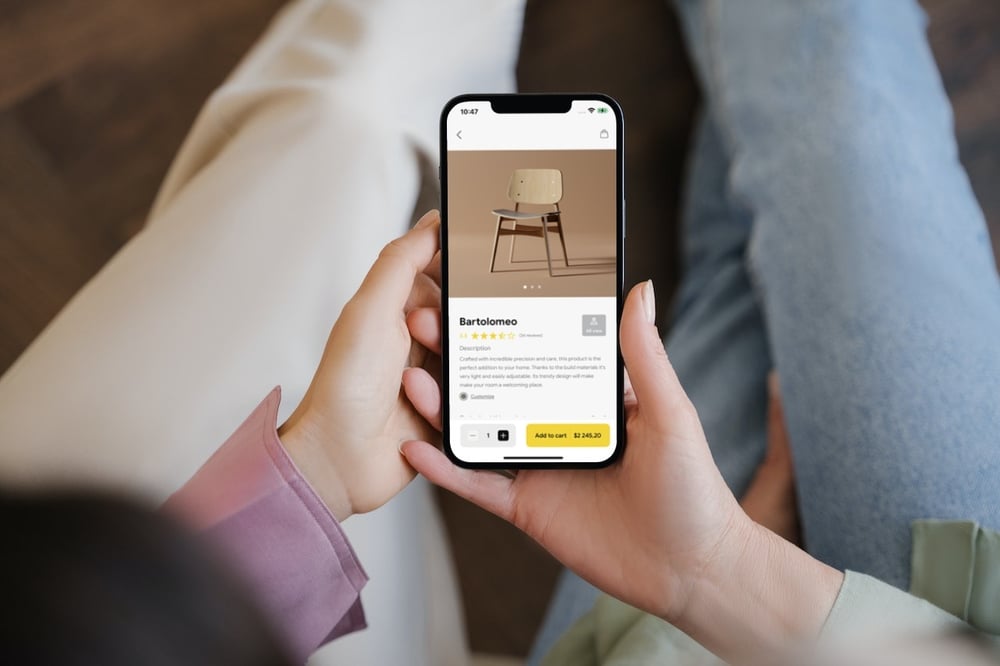
However, as business owners very well recognize, the competition for user attention is quite harsh. While there are over 3.5 million mobile apps in the Google Play Store and 1.6 million applications in the Apple App Store, the average global user has 93 apps on their phone, using 41 apps per month.
Inevitably, there’s a considerable number of apps out there barely used by enough users. There’s an oversupply of software, while user attention is limited. To stand out from the crowd, businesses must make a serious effort to build products well-fitted to market needs.
To help businesses and organizations achieve this, this guide offers some tips in creating a mobile application. When working with a partner that delivers mobile app development services, I encourage you to bring up each and every point. This article will benefit entrepreneurs, executives, and decision-makers who want to translate their product vision into a successful custom mobile app.
How to make a successful app?
A successful app combines three aspects in a smart way: the market, the user, and the product itself. All these factors need to work together to give users value, usability, and performance.
So, what makes an app a successful one? We can divide the qualities of a successful mobile app into two main categories: consumer-centric and business-centric.
Consumer-centric qualities
These are the key qualities of a consumer-centric mobile app:
- The product design is not only visually appealing, but also highly tailored towards user needs.
- Where the user interface (UI) and user experience (UX) is self-explanatory. There’s no need for documentation or lengthy explanations. The app itself leads the user.
- Covers key expectations and needs based on how people use a specific service
- Stable, reliable workflow
- Provides sufficient level of data protection
- Offers quick access to customer support
- Built with digital accessibility, wherein customers are able to use the app independently, regardless of their ability or circumstance.
Business-centric qualities
These are the key qualities of a business-centric mobile app:
- The app and feature updates can be readily shipped provided business conditions are met
- Facilitates user growth and retention
- Offers quick, hassle-free payments (if the app requires a payment feature)
- Protects against data breaches
- Cost effective in maintenance and future development
Of course, these qualities are easier said than done. Before going into my list of key considerations in building an app, I want to showcase what I mean by a successful mobile app.
15 tips in developing a successful mobile app
If you want to build a mobile application that will meet your company’s criteria for success, consider following these 15 useful tips.
1. Identify your audience
First things first. You need to know who you want to use your app.
This will help you to check the business potential of your app idea against the market need. This exercise will also help you strategize how to communicate with your target users (i.e. marketing message), and where to communicate (i.e. channels).
How to do it?
- Search for stats and insights
- Check for trends
- Conduct qualitative and quantitative research
- Collect user feedback based on the prototype version of your mobile app.
Check every source of knowledge available. You can collect all demographic data (e.g. sex, age, gender, location), and gather information about your users’ behaviors and motivations (pains and gains). Then discuss with your team, co-founders, mentors, industry experts, and others who can provide valuable insights on your product idea.
Narrow down your target audience. The larger the group, the higher the upside for your product; at the same time the higher the odds that there’s something wrong with your app idea. It’s easier to target a specific innovation towards a niche audience.
2. Offer genuine value to customers
An app delivers value when it solves a specific problem recognized by a target group of potential users. Even the simplest form of entertainment, like the Candy Crush game, provides an outlet for stress and alleviates the boredom of the commute or standing in queues.
The application should bring an important benefit to users so they are motivated enough to download and use it. Unique value may be related to the price of a given service, the speed of information transfer, the way the application works, or providing access to features or services unavailable from another channel.
A perfect app combines in a smart way:
- Consumer needs
- Business objectives
- Technological solutions
A good product has to be either fun or useful. Redundancy is good in nature. It’s always better if your app solves more than one problem. The most successful ones do. Some people need comfortable, beautiful, and inspiring accommodation in places all around the world, while others want to rent their flat to foreigners with cash to spare.
3. Define the app’s business model
Some companies choose to monetize their apps by using various advertising-based business models. Some choose to charge users upon download, some rely on in-app purchases, and others rely on subscription-based fees.
Every mobile app business model has its advantages and drawbacks. To choose the one that fits your needs, it’s good to start with analyzing industry practices and what your competitors are doing. If it works with them, it might work with you. Or it could be an opportunity to disrupt your industry.
Note that not every successful mobile app has to generate profits. There are categories of apps, such as apps for enterprise use, that deliver value other than direct revenue. For example, some companies or organizations create apps to manage workflows or optimize business processes.
4. Define the scope of features
It’s likely that you have spent some time thinking about your product idea. You’ve already visualized the wonderful things it can do, all the features might elevate its profile. Social sharing, notifications, payments, integrations — they all seem indispensable.
It may well be the case that they are all useful features, but it may be better if you forget about them for now. Each one of them could hinder the development of your core feature. If you focus on the wrong end of the mobile app development process, you could either lose time or quality.
You might even end up overlooking the core of your product idea. Think once again about the ultimate raison d’etre of your app. Boil it down to one sentence. And then focus on it. The rest will follow.
An abundance of features may seem like a good idea, but it’s usually not. It only works for the consultancies that want to pump up the value of the contract. What users need is the simplest way to solve their problems.
Once you decide the core feature of your app, try to bring it to the fore in the clearest way. Each additional option, each personalization, each integration will make it more difficult for your users to understand the value you intend to provide. These bells and whistles also entail additional cost.
Not only is the development of more complex products more expensive, but you’ll also have to invest more time and money into customer support in the early stages.
Less is more. This is one of the key imperatives in the early stages of product development.
5. Choose the right technologies and development approach
How a mobile app is built is as impactful on its success as the way it works. If you want to build a successful application, you need to choose the right technologies following your development approach. There are three main options you can choose from.
Option 1: Platform-specific native app
Native apps are coded for a specific mobile platform — iOS or Android. The programming language used to write these apps is suited only for the operating systems of these platforms. A native app can leverage your device’s hardware and functionality to a large extent, which elevates the user experience.
Option 2: Cross-platform app
Cross-platform development is the process of building apps that can be deployed across several platforms, such as iOS and Android, based on a shared codebase. Development teams need to use cross-platform software development kits (SDKs), such as React Native and Flutter, to code them.
While you do lose some of the native advantages, this is still the most cost-effective approach if you’re on a limited budget but still want an app designed, optimized, and styled for more multiple platforms.
Option 3: Build with Kotlin Multiplatform Mobile (KMM)
Whether you’re building an app natively or through a cross-platform approach, consider Kotlin Multiplatform Mobile, a software development kit (SDK) that simplifies application development by enabling development teams to write shared business logic for both iOS and Android.
Based on our experience, Android and iOS apps built through KMM can share up to 70% of the Kotlin code. This reduces the development effort required, which can speed up delivery and decrease project cost.
While Kotlin Multiplatform doesn’t support the sharing of UI logic in developing both iOS and Android apps, this also allows developers to maximize native UI/UX capabilities for either platform. In effect, because the UI is coded separately for each platform, the interface and user experience will feel native.
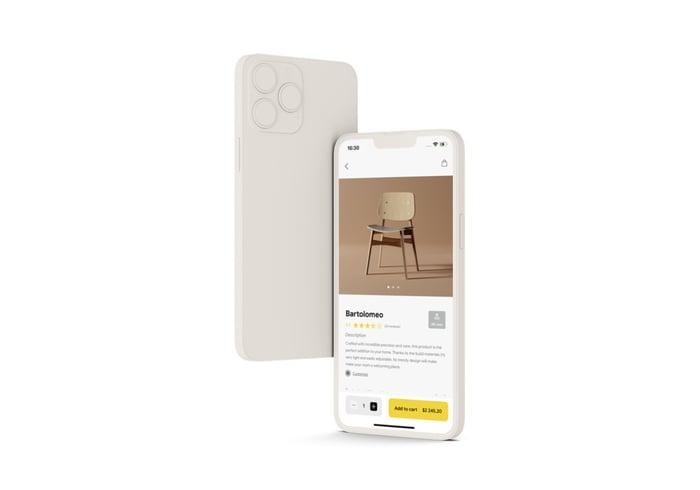
Similarly, it enables mobile apps to maximize the use of the device’s hardware capabilities, such as the camera, GPS, Bluetooth, and movement detection, among others. For applications that heavily rely on these hardware features, such as augmented reality (AR) and IoT apps, Kotlin Multiplatform Mobile can be an optimal solution.
Further, it allows optionality in code sharing. This means that you can choose to have a shared codebase only for the features or modules you want to. In fact, you can use KMM even if you intend to only be present on one platform (e.g. Android) whether or not you’re considering if you want to build on another platform (e.g. iOS) later on.
Kotlin Multiplatform isn’t necessarily a direct alternative to Flutter or React Native. Rather, it supports a native development approach by avoiding having to write similar code twice across different platforms. It offers the best out of native and cross-platform development approaches.
6. Design a simple and intuitive UX/UI
Design is one of the key ingredients to an app's success. This is true for both B2C and B2B apps. People want to use mobile apps with a simple yet intuitive UX and UI.
For example, a simple UI doesn’t obstruct information the user views in the app. A snappy UI makes the app feel seamless and easy to use from the moment a new user navigates it for the first time.
A well-designed UX and UI has been proven to translate into business results.
A well-thought-out registration process leads to better user acquisition and higher download numbers. The same goes with well-designed onboarding. When it's simple and understandable, then users will stick with your app and probably recommend it to new users. If you rely on in-app purchases, make it clear what the user will get from buying virtual goods, which will help skyrocket your app’s conversion rate.
7. Build a development team
The quality of your product significantly springs from the capabilities and effort of your mobile app development team.
An individual app developer can complete some projects, but you can also outsource the work to a development team. Further, consider engaging a full stack consultancy partner that will not only provide your business with the technical expertise but also support your market success.
Make sure that your development partner has a wide spectrum of skills, that they communicate effectively with you, and, above all, understand the scope of work you’ve given them.
8. Ensure your team is on the same page
Creative thinking and effective project execution are difficult to pair.
During a scoping session, your initial project concept could be scaled down when confronted with technology options available to your resources, and you should be ready to compromise. That is why you should always anchor your core features to the problems you want to solve and the profile of your target users.
Make sure each member of the software development team you’re working with understands the product, how it’s supposed to work, and how it’s supposed to be useful for users.
Mobile app developers are passionate about the technology they work with, and they are a great source of ideas when you really involve them in the creative process. They are motivated by finding new, creative, and efficient ways to apply their tools. You need to engage them in your vision and maximize their knowledge and skills.
9. Maintain high performance
Good is not good enough if you want your app to be successful. 53% of apps are uninstalled within 30 days from being downloaded. Simply, people get rid of apps they don’t need or want, which they decide on within a month.
One of the key factors here is the user’s experience of bugs and glitches. In a US-based survey among 1,000 users, 88% said that they would abandon an app if they encountered bugs or glitches.
Roughly 51% of them (of the 88%) said they would probably stop using the app entirely if they experienced at least one bug daily. Then, 32% of all respondents said they’ll likely abandon the app the moment they encounter a glitch.
Remember that users will hold you accountable for any problem that may come up while using your app, and not necessarily the phone manufacturer or the telco that provides the internet.
10. Ensure your app is safe
Mobile apps that don’t take security and privacy seriously pose a real threat to users. It is on our devices that we store and transfer sensitive data such as payments, banking information, access keys, medical records, personal data, etc.
There are standard practices to address security issues. However, data protection is not an easy process, especially when you have to identify specific threats and build safeguards against them.
To begin, here are some basic standard security practices that you’ll want your development team to cover:
- Proper encryption of sensitive personal data, such as the local database, cache, or API communication
- Cryptographic key management and user session authorization (tokens)
- Token validation by assigning one to each device separately and with different expiration times of sessions
- Proper implementation of safe communication standards (e.g certificate pinning in the case of HTTPs)
- General OWASP-recommended checks that you can find in a mobile security review
11. Prepare a go-to-market strategy
Many mobile apps fail because what they offer doesn't match what consumers need. This happens when companies neglect conducting market and competitor research, a well-defined product strategy, and a marketing plan to promote the product. Emphasizing these elements will come up again when it’s to ship the product to market.
When the development phase is nearing completion, businesses need to focus their strategy towards a go-to-market plan, which articulates the product's unique value proposition and the approach to gain market share.
A go-to-market strategy is uniquely focused on product distribution. This plan needs to refocus on the following:
- Segmenting the target audiences
- Formulating a marketing and sales plan for each customer segment
- Creating the messaging for the product as a solution to specific pain points and market needs
- Defining the mediums or channels where you’ll be marketing the mobile app to acquire users
- Conceptualizing the product launch
For instance, as early as product conceptualization, you may want to consider starting with a well-done mobile-first website before developing a mobile application. This will allow you to test market appetite and learn more about your users before investing additional resources to develop a mobile app.
12. Plan a marketing strategy
We’re overloaded with information and content that surrounds us. It's harder than ever to get consumer attention and present a message that will resonate with them. That’s why you need to develop a marketing strategy that carries a compelling message delivered through the right channels.
Sometimes, getting your message across takes more time than developing the product. Some businesses promote their apps before they hit the app stores. Remember that introducing your product doesn’t just entail a single burst of a marketing campaign. Your marketing strategy needs to be a sustained approach. To begin with, divide your marketing plan into three campaign phases: pre-launch, launch, and post-launch.
13. Make regular updates
Building an app in the right way and marketing it properly are two parts of a three-part matrix of a successful mobile app. The last, but not least, part of the matrix is maintaining and enhancing the app after its release. If you’re building an app, you probably want it to stay on the market, right? So don’t forget about introducing constant improvements. Pay attention to the overall quality, performance, and security.
Aside from fixing bugs and addressing technical issues, develop new relevant features and keep your app up to date. For example, continuously review the complexity of the user acquisition process (i.e. onboarding, registration forms, etc.). New technologies and approaches always emerge that make user sign ups more convenient. Users need to see that you continuously care about their experience.
Further, remember that Apple and Google constantly update their operating systems. Keeping your app coherent with recent OS changes is key. Sometimes it may mean pivoting some features or changing assumptions about your app.
14. Upgrade based on feedback
If you want to be sure that the updates you introduce to your app are relevant for users, base your decision on data. You need to know how your product is used. Analyze that information and react to it as early as you can.
Define clear KPIs that measure the success of your app. Measure as much as you can, but prioritize the KPIs you set. For example, implement a mechanism for providing more context about bugs for easy reproduction and fixes. Consider implementing a feedback form or a prompt asking users what they think.
Outlined below are some analytics platforms for mobile apps you may find useful. Nevertheless, consult with your technology team which one fits your priorities best.
15. Work on user retention
User retention rate is a key metric you should follow. It’s the total number of unique users that use an app within a specific time period of time.
The average retention rate globally across 31 mobile app categories is 25.3% on Day 1 before crashing to 5.7% by Day 30. So make sure you’re doing everything you can to keep your users engaged. But before that, collect and analyze this metric.
As this datapoint indicates, user retention rates inevitably drop no matter how engaging an app is. However, there are proven mechanisms to generate enough engagement to a level that meets your business goals. For example, you can use push notifications to remind users who downloaded the app but haven;t used it enough recently.
Onboarding, in-app messaging, and remarketing are other ways to sustain user retention. Nevertheless, always think about finding effective ways to get users back to your app.
However, remember to offer real value. If you don’t deliver any genuine value to users, they won’t use your app regardless of your engagement strategies.
Two examples of successful mobile apps
To show what I mean by “successful custom mobile app”, I’ll give you two examples.
NEONAIL, a beauty mobile app with a Virtual Try-On feature
This cross-platform app lets users virtually try on nail products before purchasing them.
NEONAIL's augmented reality app offers more than just swatches, it lets users try on nail colors and shapes with all the confidence of a manicure professional. Powered by cutting-edge computer vision algorithms coupled with machine learning models, this unique experience shows how technology can be incorporated into virtual beauty trials for effortless shopping decisions.
This complex project aiming that achieve the realistic and responsive user experience included a number of steps, among others:
- Building the PoC based on images retrieved from the internet to validate the idea of transferring complex nail patterns
- Gathering data for training the machine learning model, including movies from different mobile devices with various qualities, backgrounds, and hands
- Optimizing the detection criteria so that nails are detected with a proper balance between sensitivity and specificity.
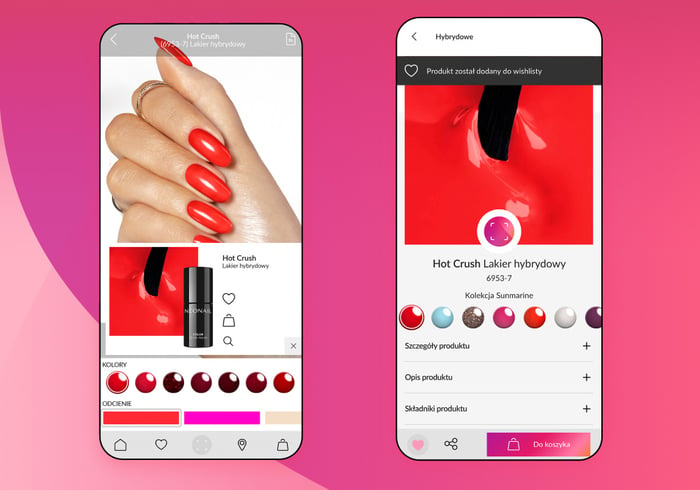
Source: Cosmo Neonail app case study
DAMAC, a real estate app
Agents now have effortless access to the latest offers and can quickly review essential information like property size, location, specifications and other features. Accessing data has never been easier.
Agents can now delight their clients with a convenient and streamlined mortgage estimation experience, showcasing the agent's efficiency. The app was designed both for iOS and Android users to ensure everyone could benefit from this solution quickly & easily.
With its inbuilt calculator featured alongside Sales Offer Creator generating PDF files within seconds - agents are equipped to dramatically accelerate sales processes.
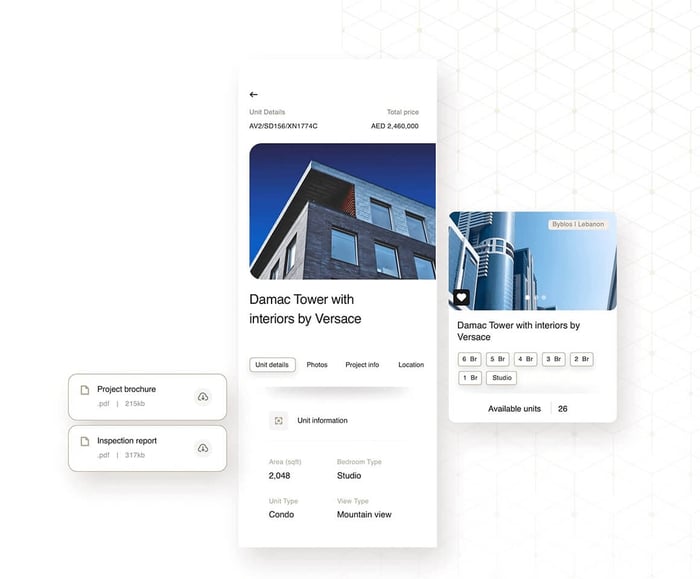
Source: DAMAC case study
Deliver your vision with the right partner
Building a successful app is not just an opportunity for a restricted clique of savvy engineers anymore. As a matter of fact, a lot of designers, entrepreneurs, marketers, and other non-engineers take the lead in the conceptualization and delivery of mobile apps.
If you have a promising idea but don't have software development skills (or access to an in-house development team), you can easily find a mobile app development partner that you can work with. This means that you don’t necessarily have to be technology-focused when conceptualizing your app-based business.
If you’ve put in the time and effort to identify problem areas, research them, understand your customers, verify product-market fit, and other product and business considerations, then the conversations about technology options can come at a later time.
Nevertheless, whether you’re already at this point in your product development journey or still ideating about your game changing mobile app, you can already benefit from engaging a full-service consultancy that can walk you through the product development process.
They can provide a full range of mobile app development services from conceptualization, research, and prototyping, all the way to implementation, launch, and maintenance. Whether you’re from a startup, a local business, or a multinational enterprise, the right partner will possess the technical competencies, infrastructure, and industry-specific expertise to deliver your vision.






